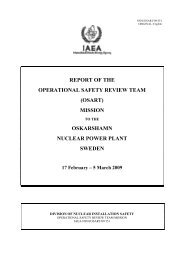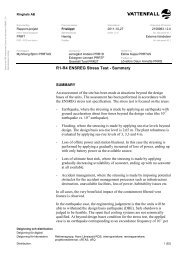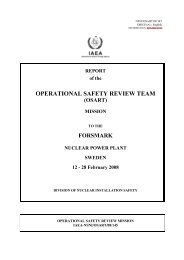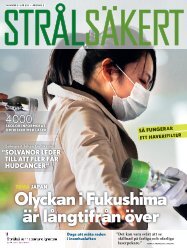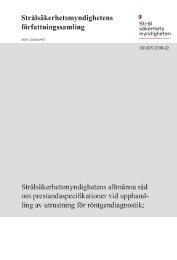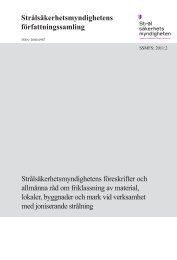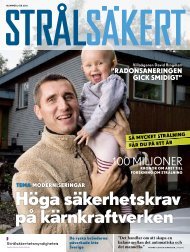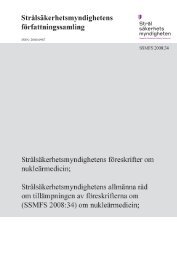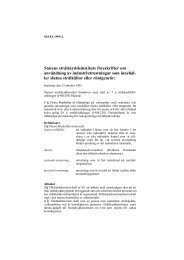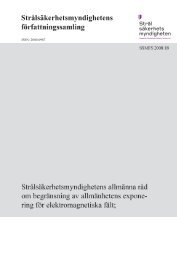Recommendation of the Finnish, Swedish, Icelandic and Norwegian ...
Recommendation of the Finnish, Swedish, Icelandic and Norwegian ...
Recommendation of the Finnish, Swedish, Icelandic and Norwegian ...
Create successful ePaper yourself
Turn your PDF publications into a flip-book with our unique Google optimized e-Paper software.
11 November 2009<br />
<strong>Recommendation</strong> <strong>of</strong> <strong>the</strong> <strong>Finnish</strong>, <strong>Swedish</strong>, <strong>Icel<strong>and</strong>ic</strong> <strong>and</strong> <strong>Norwegian</strong> Radiation Safety<br />
Authorities regarding prohibition <strong>of</strong> sunbed/solarium services to people under <strong>the</strong> age <strong>of</strong><br />
18 years.<br />
Exposure to ultraviolet radiation (UV), including solarium use, can cause severe negative<br />
health effects. The Nordic authorities <strong>the</strong>refore advise against <strong>the</strong> use <strong>of</strong> sunbeds for tanning<br />
purposes since exposure <strong>of</strong> <strong>the</strong> general population to UV-radiation should be limited (Nordic<br />
Radiation Protection <strong>and</strong> Health Authorities, 2005).<br />
A basic <strong>and</strong> internationally accepted principle for radiation protection is that any practice<br />
involving radiation must be justifiable, i.e. do more good than harm. The World Health<br />
Organisation based International Agency for Research on Cancer (WHO-IARC) has now<br />
classified UV-emitting tanning devices as “carcinogenic to humans” (IARC-News, 2009).<br />
This fact raises serious questions on <strong>the</strong> justification behind using sunbeds for tanning purposes.<br />
Young persons below 18 years <strong>of</strong> age <strong>and</strong> UV sensitive people (skin type I – II) are strongly<br />
advised not to use sunbeds (Scientific Committee for Consumer Products, 2006; Nordic<br />
Radiation Protection <strong>and</strong> Health Authorities, 2005). There is a significant increased risk for<br />
developing cutaneous malignant melanoma associated with using sunbeds, particularly for<br />
those who start using sunbeds in <strong>the</strong>ir teens <strong>and</strong> twenties (IARC, 2006).<br />
Therefore <strong>the</strong> <strong>Finnish</strong>, <strong>Swedish</strong>, <strong>Icel<strong>and</strong>ic</strong> <strong>and</strong> <strong>Norwegian</strong> Radiation Safety Authorities<br />
recommend regulation <strong>of</strong> tanning facilities open to <strong>the</strong> public that includes <strong>the</strong> prohibition<br />
<strong>of</strong> use, sale or hire <strong>of</strong> sunbeds for people below 18 years <strong>of</strong> age.<br />
Fur<strong>the</strong>r information including <strong>the</strong> rationale, relevant data <strong>and</strong> a discussion concerning<br />
recommendations on commercial sunbed services to people under <strong>the</strong> age <strong>of</strong> 18 years is<br />
provided in <strong>the</strong> Appendix.<br />
<br />
<br />
<br />
<br />
<strong>Finnish</strong> Radiation <strong>and</strong> Nuclear Safety Authority (Säteilyturvakeskus, STUK)<br />
<strong>Swedish</strong> Radiation Safety Authority (Strålsäkerhetsmyndigheten)<br />
<strong>Icel<strong>and</strong>ic</strong> Radiation Safety Authority (Geislavarnir Rikisins)<br />
<strong>Norwegian</strong> Radiation Protection Authority (Statens strålevern)
Appendix (Details, References)<br />
18 year age limit for using sunbeds/solaria for tanning purposes<br />
Exposure to ultraviolet radiation (UV), including solarium use, can cause severe negative<br />
health effects in <strong>the</strong> population. Behaviour patterns <strong>and</strong> tanning habits among <strong>the</strong> general<br />
population is <strong>of</strong> concern regarding exposure to natural solar UV; <strong>the</strong> <strong>Finnish</strong>, <strong>Swedish</strong>,<br />
<strong>Icel<strong>and</strong>ic</strong> <strong>and</strong> <strong>Norwegian</strong> authorities as well as o<strong>the</strong>r health-agencies <strong>and</strong> cancer prevention<br />
organisations are working, using information tools, towards <strong>the</strong> goal <strong>of</strong> reducing skin cancer<br />
incidence. However, with respect to artificial tanning <strong>and</strong> <strong>the</strong> use <strong>of</strong> sunbeds, though both<br />
information <strong>and</strong> legislative tools have been used <strong>and</strong> will continue to be used, stricter<br />
legislation is needed.<br />
A working group within <strong>the</strong> IARC met in June 2009 to reassess <strong>the</strong> carcinogenicity <strong>of</strong> types<br />
<strong>of</strong> radiation previously classified as “carcinogenic to humans” (Group 1) <strong>and</strong> to identify<br />
additional tumour sites <strong>and</strong> mechanisms <strong>of</strong> carcinogenesis. The IARC released <strong>the</strong> results <strong>of</strong><br />
this work on 27 July 2009 (IARC-News, 2009). With respect to solaria <strong>the</strong> working group<br />
changed <strong>the</strong> classification <strong>of</strong> <strong>the</strong> use <strong>of</strong> UV-emitting tanning devices to Group 1 i.e.,<br />
“carcinogenic to humans”. The scientific basis for this decision is that a comprehensive metaanalysis<br />
concluded that <strong>the</strong> risk <strong>of</strong> cutaneous melanoma increased when use <strong>of</strong> tanning<br />
devices started before 30 years <strong>of</strong> age (IARC, 2006). The IARC also concluded that limited<br />
data suggested that <strong>the</strong> risk <strong>of</strong> squamous cell carcinoma increased when indoor tanning<br />
facilities were first used by an individual as a teenager. In addition, <strong>the</strong> IARC concluded that<br />
artificial tanning confers little if any protection against solar damage to <strong>the</strong> skin <strong>and</strong> does not<br />
grant protection against vitamin D deficiency. Sunbeds <strong>and</strong> accompanying exposure schedules<br />
are optimized for tanning purposes <strong>and</strong> not for vitamin D production (IARC, 2008).<br />
An excessive use <strong>of</strong> sunbeds by young people in <strong>the</strong> Nordic countries has been documented<br />
<strong>and</strong> for many individuals <strong>the</strong> use <strong>of</strong> sunbeds starts well before <strong>the</strong> age <strong>of</strong> 18 (Køster et al.,<br />
2009; T. Sigurdsson, unpublished surveys by IRSA, 2004-2009; MMI, 2004; TNS Gallup,<br />
2009). Sunbed usage has also been linked to increasing rates <strong>of</strong> ery<strong>the</strong>ma, particularly in <strong>the</strong><br />
youngest age groups (SSM, 2009; MMI, 2004; TNS Gallup, 2009) 1 .<br />
Several recognised international organisations (The International Commission on Non-<br />
Ionizing Radiation Protection (ICNIRP, 2003); The Scientific Committee for Consumer<br />
Products (SCCP, 2006); WHO (WHO, 2003); <strong>and</strong> <strong>the</strong> European Society for Skin Cancer<br />
Prevention (EUROSKIN; Greinert et al., 2001) recommend that qualified personnel should<br />
guide customers with respect to tanning. In addition, <strong>the</strong> WHO <strong>and</strong> <strong>the</strong> British Committee on<br />
Medical Aspects <strong>of</strong> Radiation in <strong>the</strong> Environment (COMARE, 2009) recommend national<br />
regulation with restricted access or prohibition for those under <strong>the</strong> age <strong>of</strong> 18 years <strong>and</strong><br />
prohibition or a reduction <strong>of</strong> <strong>the</strong> number <strong>of</strong> sunbeds intended for unsupervised use <strong>and</strong>/or selfdetermined<br />
operation in commercial outlets.<br />
1 In Denmark, 59% <strong>of</strong> <strong>the</strong> girls <strong>and</strong> 42% <strong>of</strong> <strong>the</strong> boys in <strong>the</strong> age group 15-19 had used solaria <strong>the</strong> last 12 months<br />
compared to 29% in <strong>the</strong> age group 15-29 (Køster et al. 2009). 48% <strong>of</strong> <strong>the</strong> girls <strong>and</strong> 22% <strong>of</strong> <strong>the</strong> boys reported<br />
using solaria before <strong>the</strong> age <strong>of</strong> 14. In Icel<strong>and</strong>, 20% in <strong>the</strong> age group 12-15 report visiting solaria in <strong>the</strong> previous<br />
12 months according to annual questionnaires (2004-2009) (T. Sigurdsson, IRSA). In Norway, 26% <strong>of</strong> <strong>the</strong> girls<br />
<strong>and</strong> 16% <strong>of</strong> <strong>the</strong> boys had used solarium before 15 years <strong>of</strong> age, <strong>and</strong> in <strong>the</strong> age group 15-24 years those who had<br />
used solarium <strong>the</strong> last year increased from 24% to 55% from 2004 to 2009 (MMI 2004 <strong>and</strong> TNS Gallup 2009). A<br />
yearly questionnaire regarding sun-habits among <strong>the</strong> <strong>Swedish</strong> population has revealed that sunbed burns are<br />
frequent <strong>and</strong> on <strong>the</strong> rise in <strong>the</strong> age group 18-24 years, increasing from 13% in 2005 to 22% in 2008 (SSM 2009).<br />
In Norway, those experiencing ery<strong>the</strong>ma increased from 1/3 to ½ <strong>of</strong> <strong>the</strong> users from 2004 to 2009.
The <strong>Norwegian</strong>, <strong>Swedish</strong>, <strong>Finnish</strong> <strong>and</strong> <strong>Icel<strong>and</strong>ic</strong> regulations require written exposure<br />
schedules to be present for <strong>the</strong> customers <strong>and</strong> a poster advising against solarium use for those<br />
under <strong>the</strong> age <strong>of</strong> 18 years. The <strong>Norwegian</strong> Radiation Protection Authority has performed<br />
several inspection surveys (Nilsen et al., 2008; NRPA Årsmelding, 2008) which indicate a<br />
low level <strong>of</strong> compliance to national regulations. For example, 50 % <strong>of</strong> <strong>the</strong> surveyed tanning<br />
facilities in Norway did not inform customers against <strong>the</strong> use <strong>of</strong> solaria for those below 18<br />
years <strong>of</strong> age. Moreover, UV measurements collected during 2008 in 210 different sunbeds<br />
showed that permitted radiation limits were exceeded in more than half <strong>of</strong> <strong>the</strong> sunbeds<br />
studied, <strong>and</strong> that “extreme” values (more than twice <strong>the</strong> radiation limit) were observed in 5 %<br />
<strong>of</strong> <strong>the</strong> sunbeds.<br />
Several countries (see Reference #19), such as France, Spain, Portugal, Belgium, Scotl<strong>and</strong>,<br />
Germany <strong>and</strong> 6 out <strong>of</strong> 7 states in Australia have, in <strong>the</strong> period 1997 - 2009, started to regulate<br />
use <strong>of</strong> sunbeds by national laws which prohibit use <strong>of</strong> sunbeds for persons under 18 years <strong>of</strong><br />
age. In addition, several o<strong>the</strong>r European countries are in <strong>the</strong> process <strong>of</strong> legislating an 18 year<br />
age limit. The Low-voltage Directive 2006/95/EC <strong>and</strong> <strong>the</strong> European st<strong>and</strong>ard EN 60335-2-<br />
27/A1 (10/2008) on "Household <strong>and</strong> similar electrical appliances - Safety - Part 2-27:<br />
Particular requirements for appliances for skin exposure to ultraviolet <strong>and</strong> infrared<br />
radiation" already requires that <strong>the</strong> usage instructions contain a statement that UV appliances<br />
are not to be used by persons under <strong>the</strong> age <strong>of</strong> 18 years. However, <strong>the</strong> voluntary ‘certification’<br />
<strong>of</strong> sun-studios <strong>and</strong> requirements for trained staff to control usage <strong>and</strong> ascertain no use by<br />
young persons failed in Germany: Only 750 out <strong>of</strong> 5000 sun-studios were certified between<br />
2003 - Sept 2008, leading to <strong>the</strong> 18 year age restriction by law (Bundesministerium, 2009).<br />
Prohibition <strong>of</strong> <strong>the</strong> use <strong>of</strong> solaria for those under <strong>the</strong> age <strong>of</strong> 18 years is expected to reduce <strong>the</strong><br />
number <strong>of</strong> skin burns <strong>and</strong> <strong>the</strong> risk <strong>of</strong> skin cancer. This will in turn lead to reduced costs for <strong>the</strong><br />
society <strong>and</strong> reduced suffering for <strong>the</strong> individual.<br />
In conclusion it is <strong>the</strong> view <strong>of</strong> <strong>the</strong> <strong>Finnish</strong>, <strong>Swedish</strong>, <strong>Icel<strong>and</strong>ic</strong> <strong>and</strong> <strong>Norwegian</strong> Radiation<br />
Safety Authorities that <strong>the</strong> health risks associated with use <strong>of</strong> sunbeds for those under <strong>the</strong> age<br />
<strong>of</strong> 18 years far outweigh any perceived benefits, <strong>the</strong> majority that <strong>of</strong> which are psychological<br />
<strong>and</strong> cosmetic. The <strong>Finnish</strong>, <strong>Swedish</strong>, <strong>Icel<strong>and</strong>ic</strong> <strong>and</strong> <strong>Norwegian</strong> Radiation Safety Authorities<br />
<strong>the</strong>refore recommend that <strong>the</strong> use <strong>of</strong> commercial sunbeds for tanning purposes should be<br />
prohibited for people below 18 years <strong>of</strong> age.<br />
References:<br />
1. Nordic Radiation Protection <strong>and</strong> Health Authorities 2005. UV-Radiation <strong>of</strong> Sun beds.<br />
Common public health advice from Nordic radiation protection <strong>and</strong> health authorities.<br />
2. IARC 29/07/2009. Lyon, France. http://www.iarc.fr/en/mediacentre/iarcnews/2009/sunbeds_uvradiation.php<br />
(31.8.2009).<br />
3. Special Report: Policy. A review <strong>of</strong> human carcinogens – Part D: radiation.<br />
www.<strong>the</strong>lancet.com/oncology Vol 10 August 2009; 751-2.<br />
4. IARC Working Group. The association <strong>of</strong> use <strong>of</strong> sunbeds with cutaneous malignant<br />
melanoma <strong>and</strong> o<strong>the</strong>r skin cancers: a systematic review. Int J Cancer 2006; 120: 1116-<br />
22.<br />
5. IARC (2006). Exposure to artificial UV radiation <strong>and</strong> skin cancer. IARC Working<br />
Group Reports Vol.1. Lyon: International Agency for research on Cancer.<br />
6. IARC (2008). Vitamin D <strong>and</strong> Cancer. IARC Working Group Reports Vol 5.<br />
7. WHO (2003). Artificial tanning sunbeds – risks <strong>and</strong> guidance. WHO, Geneva.
8. The International Commission on Non-Ionizing Radiation Protection (2003) ICNIRP<br />
Statement. Health issues <strong>of</strong> ultraviolet tanning appliances used for cosmetic purposes.<br />
Health Physics, 84, 119-127.<br />
9. Scientific Committee on Consumer Products, European Commission Health <strong>and</strong><br />
Consumer Protection Directorate General (2006) Opinion on Biological effects <strong>of</strong><br />
ultraviolet radiation relevant to health with particular reference to sunbeds for<br />
cosmetic purposes. European Commission Health <strong>and</strong> Consumer Protection<br />
Directorate General.<br />
http://ec.europa.eu/health/ph_risk/committees/04_sccp/docs/sccp_o_031b.pdf.<br />
(31.8.2009).<br />
10. Greinert, R., A. McKinlay <strong>and</strong> E.W. Breitbart (2001) The European Society <strong>of</strong> skin<br />
cancer prevention – EUROSKIN: towards <strong>the</strong> promotion <strong>and</strong> harmonization <strong>of</strong> skin<br />
cancer prevention in Europe. <strong>Recommendation</strong>s. Eur J Cancer Prev, 10: 157-162.<br />
11. Committee on Medical Aspects <strong>of</strong> Radiation in <strong>the</strong> Environment (COMARE) (2009):<br />
Thirteenth Report. The health effects <strong>and</strong> risks arising from exposure to ultraviolet<br />
radiation from artificial tanning devices.<br />
http://www.comare.org.uk/documents/COMARE13thReport.pdf (12.10.2009)<br />
12. Surveys on tanning habits. MMI in 2004 <strong>and</strong> TNS Gallup in March 2009 for The<br />
<strong>Norwegian</strong> Cancer Society <strong>and</strong> <strong>the</strong> <strong>Norwegian</strong> Radiation Protection Authority. The<br />
survey in March 2009 is given as Undersøkelsen i 2009 gjengitt som nyhetssak hos<br />
Kreftforeningen:<br />
http://www.kreftforeningen.no/forebygging/solvett_og_hudkreft/solarium/bruker_sola<br />
rium_f_r_de_er_18__r__ndash__utsatt_for_hudkreft_13228 (25.9.2009)<br />
13. Køster B, Thorgaard C, Clemmensen IH et al. Sunbed use in <strong>the</strong> Danish population in<br />
2007: a cross sectional study. Prev Med 2009; 48: 288-90.<br />
14. Gulliksson, Westermark, Wester: Recurrent Investigation on Tanning <strong>and</strong> Out-door<br />
Habits for an Indicator <strong>of</strong> UV-exposure, Poster at COST-726 Seminar, Warszaw 13-14<br />
May 2009.<br />
15. Nilsen LTN, Hannevik M, Aalerud TN et al. Ultraviolet irradiance from tanning<br />
devices in 1983-2005: all approved devices <strong>and</strong> <strong>the</strong> results <strong>of</strong> two inspection surveys<br />
in Norway. Photochem Photobiol 2008; 84: 1100-08.<br />
16. Nilsen LTN, Aalerud TN, Johnsen B et al. Indoor tanning in Norway. Regulations <strong>and</strong><br />
inspections. StrålevernRapport 2000:9. Østerås: Statens strålevern, 2008.<br />
17. Årsmelding 2008. Østerås: Statens strålevern, 2008.<br />
http://www.nrpa.no/archive/Internett/Publikasjoner/Annet/Arsmelding_2008.pdf<br />
(31.8.2009).<br />
18. Nilsen LTN, Aalerud TN, Hannevik M, Veierød MB. UV irradiance in <strong>Norwegian</strong><br />
sunbeds. Posterpresentasjon ved den 15. Internasjonale Kongress for Fotobiologi,<br />
Düsseldorf, Tyskl<strong>and</strong> 18-23. juni 2009.<br />
19. France; Decree No. 97-617 <strong>of</strong> 30 May 1997, Spain; Real Decreto 1002/2002 <strong>of</strong> 27<br />
September, Belgium; Royal Decree. Arrêté royal modifiant l’arrêté royal du 20 juin<br />
2002 relatif aux conditions d’exploitation des centres de bronzage (22.11.2007),<br />
Germany; “Gesetz zur Regelung des Schutzes vor nichtionizierender Strahlung<br />
(19.6.2009), Scotl<strong>and</strong>; Scottish Parliament (2008). Public Health etc. (Scotl<strong>and</strong>) Act<br />
2008 (asp 5), Portugal; Decree-Law No 242 <strong>of</strong> 20 December 2005, Australia;<br />
Makin&Dobbinson “Changes in solarium numbers in Australia following negative<br />
media <strong>and</strong> legislation” Aust N Z J Public Health. 2009; 33:491-4.<br />
20. Bundesministerium: “Begrundung – Gesetz zur Regelung des Schutzes vor<br />
nichtionisierender Strahlung”, Bundesministerium fur Umwelt, Naturschutz und<br />
Reaktorsicherheit”, p.11 (RS II 1 – 15981), Bonn 16.02.2009.



